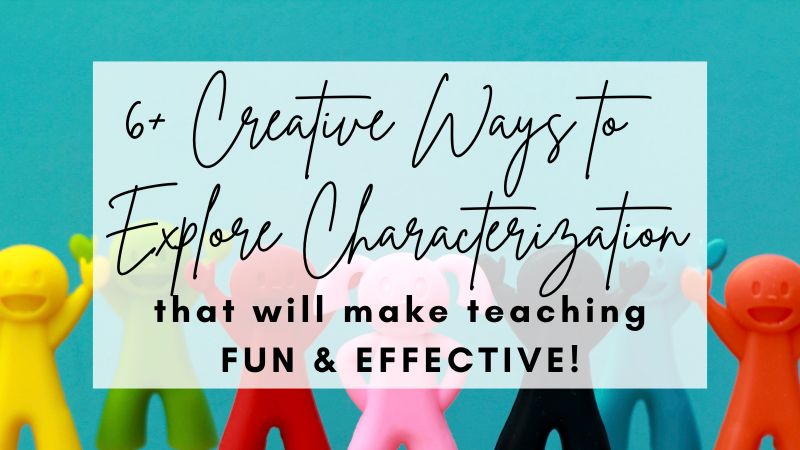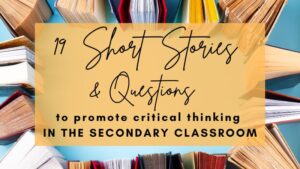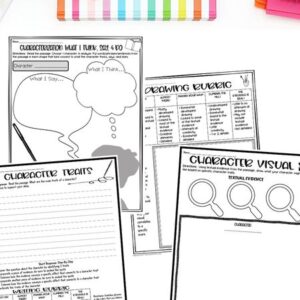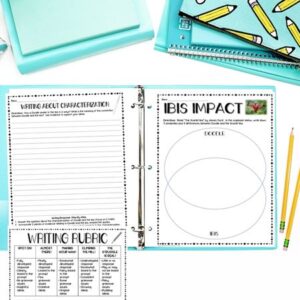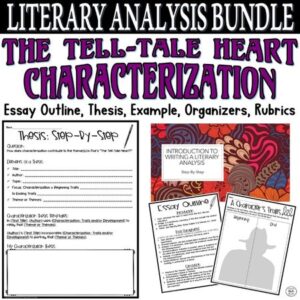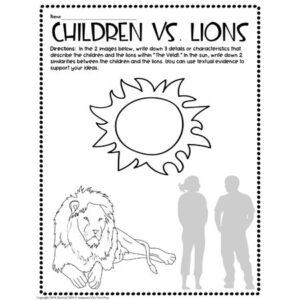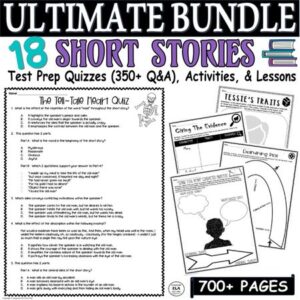There’s that old saying that if it ain’t broke, don’t fix it. Certainly, there are moments as teachers when we realize that we’ve been teaching the same thing for quite a while. And yes, we know it works! For me, this includes my lessons for teaching character traits and characterization. But there’s something to be said for trying something new.
For one thing, it means freshening things up for yourself and your students. Teaching and even learning the same things year after year can quickly become monotonous, so a change can be welcome. Plus, if you know you have a reliable option in your back pocket, you might be willing to take a risk knowing you have a fall-back lesson if things go up in smoke!
So let’s ignore that it’s not broken and still try something different…
Keep reading for creative ideas to further explore characterization in your English classroom!
Need help with Test Prep? Check out this FREE Pack of 3 Test Prep Activities to help students achieve success on standardized tests!

Let’s Define Character Traits versus Characterization
Character traits are the individual elements that make up a character’s personality such as behavior, attitudes, and physical, emotional, or mental descriptors.
To understand character traits students can answer the question: What words would I use to describe this character?
Answers could include stubborn, funny, well-dressed, honest, adventurous, and so on.
Characterization meanwhile is the sum of all of these individual elements. It refers more to writing techniques employed by an author, namely the way the author communicates a character’s personality and overall persona.
As a result, characterization can be direct or indirect. Many teachers explore characterization through an approach represented by the acronyms STEAL or PAIRS.
S – Speech – What the character says
T – Thoughts – What the character thinks
E – Effect(s) – How the character makes others feel/think
A – Actions – What the character does
L – Looks – How the character looks
&
P – Physical description
A – Actions
I – Inner thoughts
R – Reactions
S – Speech
In each version, students spend time getting to know their characters deeply as well as the author’s writing techniques to develop said characters.
Need a ton of ready-to-go questions for short stories? Click below!
Why Explore Characterization?
Exploring characterization can lead to a better understanding of a story’s meaning, message, or overall purpose. It often means added depth of analysis for the text in question, too.
Spending time on characterization means examining relationships between characters and between stories. Looking at characters’ motivations, conflicts, and hopefully, their growth can expand students’ background knowledge. This means they might find patterns in character development, which can lead to success when tackling more challenging texts.
6+ Ideas to Explore Characterization
The common approaches to characterization using the aforementioned acronyms (STEAL and PAIRS) are a great starting point, but if you’re looking to switch things up and expand your approach to characterization, here are some additional ideas to use in your ELA classes.
1. Personal reflection and inventory
Begin with a personal application of character traits through a personal inventory before applying the same process to a fictional character.
Download this FREE My Traits Graphic Organizer Pack focused on characterization that helps students to identify internal and external traits by connecting them to their own personal traits.
For pretty much ANY secondary class, this activity is easy to teach and implement as a beginning to teaching characterization!
2. Teach traits with student connections
Using a Who Am I? approach, students can self-identify and make guesses about others. You can use different movement-based activities such as stand up/sit down or even four corners to have students define, understand, and connect with specific traits.
To do this activity, name a character trait and have students either stand up if they have this trait or remain seated if they don’t or they can move to a corner that represents I have a LOT of this trait, a LITTLE of this trait, NONE of this trait, or (to keep it less personal) I know someone who definitely has this trait.
Once they make a decision, they can discuss how this trait presents in them. This is good practice before turning to examine a writer’s technique. For example, student A shows his or her anger by getting teary-eyed and red-faced but a character in a short story may demonstrate anger through a raised voice.
3. Practice with familiar texts
Almost every student is familiar with at least one fairy tale such as The Little Mermaid, Cinderella, Snow White, Hansel & Gretel, The Princess and the Pea, The Ugly Duckling, Little Red Riding Hood, etc. So use such familiar texts to help identify traits.
If you want to present poetry as an option, which I recommend since integrating poetry throughout different units can make it feel less daunting, then use this resource with Walt Whitman’s Song of Myself or even this one with Percy Bysshe Shelley’s Ozymandias.
There are so many poems to choose from that emphasize characterization. See this poetry bundle for plenty of options!
4. Incorporate visualization
Incorporating visuals can be helpful for students who find identifying character traits more challenging. While listening to or reading a story, have students draw the character. Emphasize that this is not about how artistic the drawing is, instead, it’s about how accurate the visual will be based on the provided information.
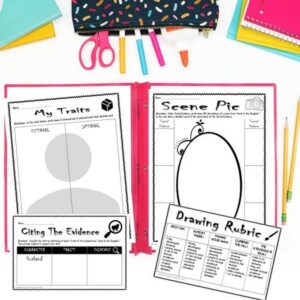
To differentiate for your students try this approach with these activities using Roald Dahl’s classic short story Lamb to the Slaughter.
5. Analyze Film Clips
Short films are a great start for characterization. Try using shorts without dialogue to encourage a closer examination through indirect characterization. Try this 2009 Oscar-winning animated short called Oktapodi and use this resource with film techniques, analysis prompts, and more that can be used with any film!
6. Change perspectives
Have students write from a different character’s perspective in the story. They don’t need to rewrite the whole story, just pick a key scene or section. This is particularly helpful when a story only shares a single perspective. The process will help students identify the character traits of the different characters as well as how to reveal a main character’s traits in a ‘new’ way.

Short Stories to Use in Your Next Characterization Lesson
1. The Scarlet Ibis by James Hurst
This impactful story featuring two brothers provides a great chance to compare and contrast the narrator and his younger brother, Doodle. Focus on the title and symbolism within if you really want to capture the full depth of characterization in this short story!
If you want easy-to-teach organizers to teach “The Scarlet Ibis,” click here!
2. The Tell-Tale Heart by Edgar Allan Poe
This Edgar Allan Poe classic would be a great choice for studying the character traits of the narrator and his presentation of mental health issues. Following the narrator’s progression from start to finish will certainly make your students deep-dive into characterization!
This step-by-step literary analysis resource will help you save time as you focus on characterization in “The Tell-Tale Heart!”
3. The Most Dangerous Game by Richard Connell
This short story is perfect for dissecting the indirect characterization of the protagonist and antagonist of the story – Rainsford and Zaroff. One could argue that perhaps the protagonist becomes the antagonist by the end of the story. Challenge your students to answer this question after reading the story!
If you need more ideas for teaching “The Most Dangerous Game,” check out the post below!
4. The Veldt by Ray Bradbury
This dystopian story of technology gone wrong can lead to a close reading of the characterization within. There is most certainly a connection between the children and the lions. How similar are these very different beings?
5. The Pedestrian by Ray Bradbury
This Ray Bradbury story is simple in terms of character presentation but makes it so the main character, Leonard, can be contrasted with his society. This story is ideal for characterization and imagery since both techniques feature prominently in the story. Additionally, this story can be taught within a single class period. Upper middle and high school students will enjoy the brevity as well as the ending.
Teaching characterization begins early in elementary school, but it doesn’t mean it should end there. Instead, teaching characterization in high school English is necessary, too!
Once students are in high school their abilities to dissect texts, think more critically, and analyze more deeply have been honed so spending more time on characterization, especially with more challenging texts, is ideal. Exploring characterization in familiar fictional texts and even in more sophisticated and complex fictional texts can challenge students’ abilities and refine their skills even more.
SHORT STORIES READ IN HIGH SCHOOL BIG RESOURCE
This Short Story ULTIMATE BUNDLE with Lessons, Quizzes, and Activities uses the Common Core standards with reading comprehension QUESTIONS and ANSWERS for 18 short stories such as “The Most Dangerous Game,” “The Monkey’s Paw,” “The Tell-Tale Heart,” “After Twenty Years,” “The Gift of the Magi,” “The Veldt,” “The Lottery,” “The Pedestrian,” etc. modeled after various state reading exams.
Make teaching short stories SIMPLE & EASY!
Just PRINT & TEACH!!
Crave more fun ideas for teaching characterization? Check out my store Kristin Menke-Integrated ELA Test Prep!

